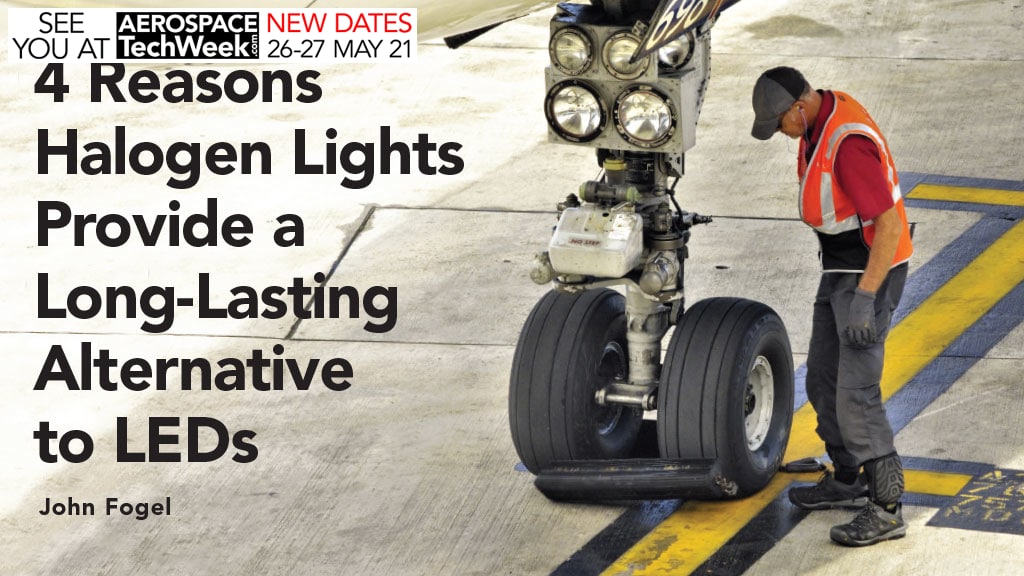Even in the age of LEDs, halogen landing and taxi lights shine. Although many new aircraft come standard with LEDs, halogen remains more cost-effective for older planes for several reasons. One is the enduring popularity of halogen as most existing aircraft were manufactured before the introduction of LEDs. When you consider that the average lifespan of an aircraft is 20 years, it’s no surprise that halogen lamps are a fixture on 90% of existing aircraft. In addition, some airlines refurbish aircraft to extend the life of their fleet, making it likely that halogen lamps will be around for years to come.
Here are four reasons why halogen PAR (parabolic aluminized reflector) lamps make an excellent, cost-effective alternative to expensive LED lights:
1) Halogen is cost-effective for existing aircraft fleets that continue to dominate the skies
One LED lamp can cost more than 20 times the cost of a halogen bulb. If replacing halogen lamps on a single aircraft is a substantial investment, consider the cost of installing LEDs for an entire fleet. For example, one major airline maintains approximately 1,300 aircraft. About 1,000 of these are Boeings and Airbuses that were manufactured when halogen lamps were the order of the day. Most of these aircraft still require two landing lights and two taxi lights, meaning that the cost of replacing halogen bulbs with LED lights would cost around $1.2 million. With COVID-19 wreaking havoc on travel plans and federal relief held up by congressional gridlock, few airlines are able or willing to invest this kind of money in lighting.
2) Long life means less maintenance needed to change out bulbs, downtime and delays
While halogen bulbs don’t have the same longevity as LED lights, a halogen PAR landing light can last 100 to 300 hours, provided it is not damaged during landing or takeoff. A halogen taxi lamp can last even longer—up to 1,000 hours in many cases. An aircraft that locates its lights on the wing, behind a room temperature vulcanized silicone shield that must be unbolted and removed to access the lights, may require a full day to replace lighting, whereas an aircraft that places lights in easier to reach locations can be serviced in as little as an hour.
3) Brightness and durability last throughout the life of the lamp
Well-made halogen lamps will maintain candela output (the measurement of illumination produced by an output beam) that exceeds industry standards. Halogen lamps can withstand countless takeoffs and landings thanks to advancements in the design of filaments and the light weight of lamps. However, it is worth noting not all halogen lamps are created equal. Some lower quality lamps produce less than half the industry-mandated candela output, which can increase the chance of collisions and other accidents. Poor visibility is also a common source of complaints from pilots tasked with providing a smooth flight—and safe landing—for their passengers.
4) Halogen is regularly available, and high-quality options are available from different manufacturers
When it comes time to replace the lights on their aircraft, airlines should make sure they purchase high quality halogen lamps that produce at least 700,000 candelas from reputable manufacturers, follow instructions in the IPC (Illustrated Parts Catalog) and change gaskets according to the recommended manufacturer’s schedule. To find a reputable manufacturer, airlines should consider the quality of the lab and procedures used for product testing, the quality of the materials used, whether the manufacturer adheres to all IPC requirements and the availability of robust customer support.
Finding a long-lasting, cost-effective lighting solution during lean economic times is vital because replacing lights can be a labor-intensive and time-consuming process. With COVID-19 disrupting travel plans, airlines must find cost-effective options for their taxi and landing lights. For existing aircraft, replacing lights with halogen bulbs provides a durable, economical alternative to LED lighting. In addition to better pricing, high quality halogen bulbs can reduce maintenance costs and lost revenue due to delayed flights. For airlines to thrive during tough times, halogen lamps offer a combination of efficiency, durability and affordability that is hard to beat.
John Fogel, Halogen Product Manager at Amglo, has worked with the company for more than 10 years in product development, qualifying products with the FAA, and building partnerships. For more information, visit www.amglo.com
